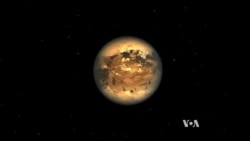Not too big, not too small. Not too hot, not too cold. A newly discovered planet looks just right for life as we know it, according to an international group of astronomers.
Orbiting a star about 500 light-years away, the planet called Kepler-186f is about the same size as Earth. As this artist’s interpretation shows, it orbits its star at the right distance for liquid water on the surface. That is an essential condition for life as we know it.
But it is not exactly like Earth, NASA planetary scientist Elisa Quintana said via Skype.
“It’s more of an Earth’s cousin. It’s not an Earth’s twin. It shares the same characteristics as Earth, but their parent stars are very different," said Quintana.
Kepler-186f orbits a star that is smaller and cooler than our sun.
But, writing in the journal Science, the astronomers say the planet appears to be a closer relative than most of the hundreds of others discovered so far.
Some are massive gas-covered giants with thick, crushing atmospheres. Others orbit too closely to their stars and are too hot for life.
Two planets discovered last year are in the right orbit and might be good candidates for life, Quintana says, but they are a bit bigger than Earth.
“For the first time, we can actually say we now have a planet that is both Earth-sized and orbits in its star’s habitable zone," she said.
It may be the first time, but it probably is not the last, says Massachusetts Institute of Technology astrophysicist Sara Seager. She spoke to VOA via Skype.
“We’ve been waiting decades to understand how common habitable planets might be, and it’s looking like they’re really common. And this gives us excitement and motivation to take the next step," said Seager.
The next step would be to look for traces of life in the atmospheres of these distant worlds. That would take a more sophisticated space telescope. But budget cuts threaten that mission, says University of California at Los Angeles astrophysicist Ben in this Skype interview.
“In principle, we could do this in the next couple decades. But in practice, because there’s no money, it’s not gonna happen. It’s not gonna happen in my lifetime, for example," said Zuckerman.
Leaving earthbound concerns behind, NASA’s Elisa Quintana believes that when the next-generation space telescope is launched, it will find that we are not alone in the universe.
“I guess I’m an optimist. I think that life is definitely out there. Just looking at the abundance of stars. I mean, hundreds of billions of stars. The likelihood that one of them might have some form of life to me seems rather high. But everyone has their own opinion about that, I’m sure," she said.
In the meantime, the search continues for other worlds where life may find a home.
Orbiting a star about 500 light-years away, the planet called Kepler-186f is about the same size as Earth. As this artist’s interpretation shows, it orbits its star at the right distance for liquid water on the surface. That is an essential condition for life as we know it.
But it is not exactly like Earth, NASA planetary scientist Elisa Quintana said via Skype.
“It’s more of an Earth’s cousin. It’s not an Earth’s twin. It shares the same characteristics as Earth, but their parent stars are very different," said Quintana.
Kepler-186f orbits a star that is smaller and cooler than our sun.
But, writing in the journal Science, the astronomers say the planet appears to be a closer relative than most of the hundreds of others discovered so far.
Some are massive gas-covered giants with thick, crushing atmospheres. Others orbit too closely to their stars and are too hot for life.
Two planets discovered last year are in the right orbit and might be good candidates for life, Quintana says, but they are a bit bigger than Earth.
“For the first time, we can actually say we now have a planet that is both Earth-sized and orbits in its star’s habitable zone," she said.
It may be the first time, but it probably is not the last, says Massachusetts Institute of Technology astrophysicist Sara Seager. She spoke to VOA via Skype.
“We’ve been waiting decades to understand how common habitable planets might be, and it’s looking like they’re really common. And this gives us excitement and motivation to take the next step," said Seager.
The next step would be to look for traces of life in the atmospheres of these distant worlds. That would take a more sophisticated space telescope. But budget cuts threaten that mission, says University of California at Los Angeles astrophysicist Ben in this Skype interview.
“In principle, we could do this in the next couple decades. But in practice, because there’s no money, it’s not gonna happen. It’s not gonna happen in my lifetime, for example," said Zuckerman.
Leaving earthbound concerns behind, NASA’s Elisa Quintana believes that when the next-generation space telescope is launched, it will find that we are not alone in the universe.
“I guess I’m an optimist. I think that life is definitely out there. Just looking at the abundance of stars. I mean, hundreds of billions of stars. The likelihood that one of them might have some form of life to me seems rather high. But everyone has their own opinion about that, I’m sure," she said.
In the meantime, the search continues for other worlds where life may find a home.






